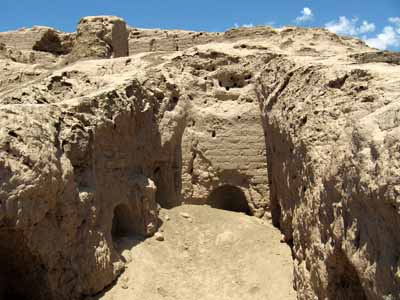From Khiva I wandered on down the Amu Darya River (also known as the Oxus) to the city of Nukus. Actually I did not want to go to Nukus. I was much more interesting in the ruins of the old Silk Road cities and fortresses scattered along the north bank of the Amu Darya, but my driver insisted that all tourists who come this way go to Nukus to visit the Karakalpakstan State Museum of Art. Unfortunately he did not point out why all tourists go to the Karakalpakstan State Museum. It turns out, according to A Recent Story In The New York Times, that this “museum in the parched hinterland of Uzbekistan . . . is home to one of the world’s largest collections of Russian avant-garde art.”
I did not know this at the time. I did peek through a few doorways into galleries containing what looked like avant-garde art, but of course I did not go in, since I have not the slightest interest in anything avant-garde and indeed little interest in any art created since the fall of the Ottoman Empire. I did spend an enjoyable couple of hours examining the museum’s fair to middling collection of Zoroastrian Ossuaries, which was especially interesting to me since I had just recently visited a Zoroastrian Tower of Silence, also on the banks of the Amu Darya, where human corpses were stripped of their flesh so their bones could be collected and placed in funeral urns like these. I also drooled over the museum’s small but mouth-wateringly delectable collection of antique Turkmen Carpets.
But enough of that. From Nukus we proceeded eastward along the northern bank of the Amu Darya through what is known as the Ellik Kala, or Fifty Forts Region. The area is dotted with ruins of cities and forts dating from perhaps the third or fourth century BC to the seventh century AD. At one time many of these settlements would have served as important way-stations on the Silk Road between Bukhara and Samarkand to the east and Kunya Urgench, farther on down the Amu Darya.
Kyzyl Kala (Fortress)
Ruins of Toprak Kala, dating to about 2000 years ago
Ruins of Toprak Kala
Ruins of Toprak Kala
Ruins of Toprak Kala
Ruins of Toprak Kala
Aerial view of the ruins of the lower fortress of Ayaz Kala. Built sometime in the 4th–7th centuries AD, the fortress may have been destroyed during the Mongol Invasion of Khorezm in the 1220s (see Enlargement). The ruins of the old city can be seen to the left of the fortress.
Ruins of the lower fortress of Ayaz Kala
Ruins of the lower fortress of Ayaz Kala
Ruins of the lower fortress of Ayaz Kala
Just north of the Lower Fortress on a higher summit is another larger fortress dating back to the 4th century BCE.

Aerial View of Upper Fortress (see Enlargement)
Ruins of the upper fortress of Ayaz Kala
Ruins of the upper fortress of Ayaz Kala
Ruins of the upper fortress of Ayaz Kala
















No comments:
Post a Comment